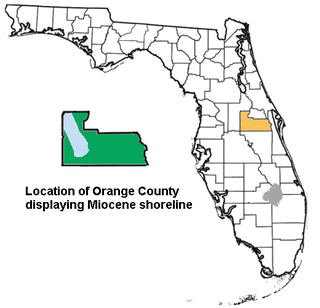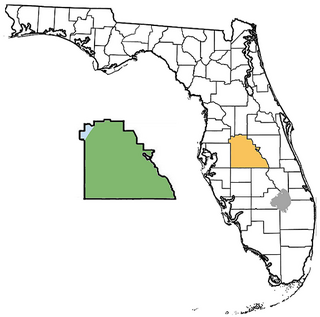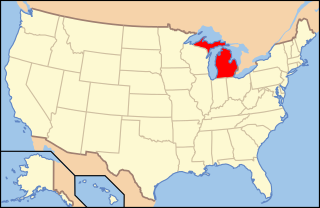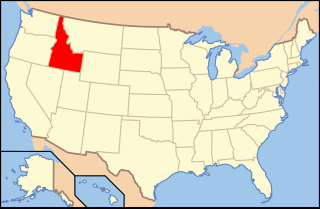
Proboscidea is a taxonomic order of afrotherian mammals containing one living family (Elephantidae) and several extinct families. First described by J. Illiger in 1811, it encompasses the elephants and their close relatives. Three species of elephant are currently recognised: the African bush elephant, the African forest elephant, and the Asian elephant.

A mastodon is a member of the genus Mammut, which, strictly defined, was endemic to North America and lived from the late Miocene to the early Holocene. Mastodons belong to the order Proboscidea, the same order as elephants and mammoths. Mammut is the type genus of the extinct family Mammutidae, which diverged from the ancestors of modern elephants at least 27–25 million years ago, during the Oligocene.

Mammutidae is an extinct family of proboscideans belonging to Elephantimorpha. It is best known for the mastodons, which inhabited North America from the Late Miocene until their extinction at beginning of the Holocene, around 11,000 years ago. The earliest fossils of the group are known from the Late Oligocene of Africa, around 24 million years ago, and fossils of the group have also been found across Eurasia. The name "mastodon" derives from Greek, μαστός "nipple" and ὀδούς "tooth", referring to their characteristic teeth.

Big Bone Lick State Park is located at Big Bone in Boone County, Kentucky. The name of the park comes from the Pleistocene megafauna fossils found there. Mammoths are believed to have been drawn to this location by a salt lick deposited around the sulfur springs. Other animals including forms of bison, caribou, deer, elk, horse, mastodon, musk ox, peccary, ground sloths, wolves, black bears, stag moose, saber-toothed cats, and possibly tapir also grazed the vegetation and salty earth around the springs that the animals relied on for their diet.

Platygonus is an extinct genus of herbivorous peccaries of the family Tayassuidae, endemic to North and South America from the Miocene through Pleistocene epochs, existing for about 10.289 million years. P. compressus stood 2.5 feet tall.

The Museum of the Earth is a natural history museum located in Ithaca, New York. The museum was opened in 2003 as part of the Paleontological Research Institution (PRI), an independent organization pursuing research and education in the history of the Earth and its life. Both PRI and the Museum of the Earth are formally affiliated with Cornell University. The Museum of the Earth is home to Earth science exhibits and science-related art displays with a focus on the concurrent evolution of the Earth and life.

Melbourne Bone Bed is a paleontological site located at Crane Creek in Melbourne, in the U.S. state of Florida. This site contains fossils from the Late Pleistocene period 20,000 to 10,000 years before the present. The fossils include extinct animals such as varieties of camels, dire wolves, Florida cave bears, giant armadillos, giant beavers, giant bison, giant ground sloths, mammoths, mastodons, saber-toothed cats, and tapirs.

The Orange County paleontological sites are assemblages of Late Pleistocene vertebrates occurring in Orange County, Florida.

The Polk County paleontological sites are assemblages of Early Miocene to Late Pleistocene vertebrates occurring in Polk County, Florida, United States.

The Yukon Beringia Interpretive Centre is a research and exhibition facility located at km 1423 on the Alaska Highway in Whitehorse, Yukon, which opened in 1997. The focus of the interpretive centre is the story of Beringia, the 3200 km landmass stretching from the Kolyma River in Siberia to the Mackenzie River in Canada, which remained non-glaciated during the Pleistocene due to light snowfall from an arid climate. Beringia is of special interest to archeologists and paleontologists as it played a crucial role in the migrations of many animals and humans between Asia and the Americas. The term Beringia was first coined by the Swedish botanist Eric Hultén in 1937.
Throughout the State of Michigan in the United States, many people have found the remains of Pleistocene mammals, almost exclusively mammoths and mastodons. Most of these fossils are found by farmers or construction workers, but most are now in the collection of the University of Michigan. The finding of vertebrate fossils in Michigan is quite rare, so it is best to turn over any specimens to a university or museum for proper cleaning and documentation. Many of these mastodon fossils are found in Southern Michigan, mostly around Ann Arbor. Most mammoth sites are in Northern Michigan.

Paleontology in Michigan refers to paleontological research occurring within or conducted by people from the U.S. state of Michigan. During the Precambrian, the Upper Peninsula was home to filamentous algae. The remains it left behind are among the oldest known fossils in the world. During the early part of the Paleozoic Michigan was covered by a shallow tropical sea which was home to a rich invertebrate fauna including brachiopods, corals, crinoids, and trilobites. Primitive armored fishes and sharks were also present. Swamps covered the state during the Carboniferous. There are little to no sedimentary deposits in the state for an interval spanning from the Permian to the end of the Neogene. Deposition resumed as glaciers transformed the state's landscape during the Pleistocene. Michigan was home to large mammals like mammoths and mastodons at that time. The Holocene American mastodon, Mammut americanum, is the Michigan state fossil. The Petoskey stone, which is made of fossil coral, is the state stone of Michigan.

Paleontology in Maryland refers to paleontological research occurring within or conducted by people from the U.S. state of Maryland. The invertebrate fossils of Maryland are similar to those of neighboring Delaware. For most of the early Paleozoic era, Maryland was covered by a shallow sea, although it was above sea level for portions of the Ordovician and Devonian. The ancient marine life of Maryland included brachiopods and bryozoans while horsetails and scale trees grew on land. By the end of the era, the sea had left the state completely. In the early Mesozoic, Pangaea was splitting up. The same geologic forces that divided the supercontinent formed massive lakes. Dinosaur footprints were preserved along their shores. During the Cretaceous, the state was home to dinosaurs. During the early part of the Cenozoic era, the state was alternatingly submerged by sea water or exposed. During the Ice Age, mastodons lived in the state.

Paleontology in Florida refers to paleontological research occurring within or conducted by people from the U.S. state of Florida. Florida has a very rich fossil record spanning from the Eocene to recent times. Florida fossils are often very well preserved.

Paleontology in Vermont comprises paleontological research occurring within or conducted by people from the U.S. state of Vermont. Fossils are generally uncommon in Vermont. Nevertheless, however, significant finds have been made in the state. Very few fossils are known in Vermont east of the Green Mountains due to the type of rock underlying that area. During the early part of the Paleozoic era, Vermont was covered by a warm, shallow sea that would end up being home to creatures like brachiopods, corals, crinoids, ostracoderms, and trilobites. There are no rocks in the state from the Carboniferous, Permian, Triassic, or Jurassic periods. The few Cretaceous rocks present contain no fossils. The Paleogene and Neogene periods are also absent from the local rock record. During the Ice Age, glaciers scoured the state. At times the state was inundated by seawater, allowing marine mammals to venture in. After the seawater drained away the state was home to mastodons. Local fossils had already attracted scientific attention by the mid-19th century when mastodon remains were found in Rutland County. In 1950 a major Paleozoic invertebrate find occurred. The Pleistocene Beluga whale Delphinapterus leucas is the Vermont state fossil.

Paleontology in Kansas refers to paleontological research occurring within or conducted by people from the U.S. state of Kansas. Kansas has been the source of some of the most spectacular fossil discoveries in US history. The fossil record of Kansas spans from the Cambrian to the Pleistocene. From the Cambrian to the Devonian, Kansas was covered by a shallow sea. During the ensuing Carboniferous the local sea level began to rise and fall. When sea levels were low the state was home to richly vegetated deltaic swamps where early amphibians and reptiles lived. Seas expanded across most of the state again during the Permian, but on land the state was home to thousands of different insect species. The popular pterosaur Pteranodon is best known from this state. During the early part of the Cenozoic era Kansas became a savannah environment. Later, during the Ice Age, glaciers briefly entered the state, which was home to camels, mammoths, mastodons, and saber-teeth. Local fossils may have inspired Native Americans to regard some local hills as the homes of sacred spirit animals. Major scientific discoveries in Kansas included the pterosaur Pteranodon and a fossil of the fish Xiphactinus that died in the act of swallowing another fish.

Paleontology in Idaho refers to paleontological research occurring within or conducted by people from the U.S. state of Idaho. The fossil record of Idaho spans much of the geologic column from the Precambrian onward. During the Precambrian, bacteria formed stromatolites while worms left behind trace fossils. The state was mostly covered by a shallow sea during the majority of the Paleozoic era. This sea became home to creatures like brachiopods, corals and trilobites. Idaho continued to be a largely marine environment through the Triassic and Jurassic periods of the Mesozoic era, when brachiopods, bryozoans, corals, ichthyosaurs and sharks inhabited the local waters. The eastern part of the state was dry land during the ensuing Cretaceous period when dinosaurs roamed the area and trees grew which would later form petrified wood.

The Cerutti Mastodon site is a paleontological and possible archeological site located in San Diego County, California. In 2017, researchers announced that broken mastodon bones at the site had been dated to around 130,700 years ago.

The Burning Tree Mastodon site in Heath, southern Licking County, Ohio, represents the location where the most complete skeleton of American mastodon was found. It is dated to about 11,500 BP. It is believed that there was human presence at the site at that time.

The research history of Mammut is extensive given its complicated taxonomic and non-taxonomic histories, with the earliest recorded fossil finds dating back to 1705 in Claverack, New York during the colonial era of what is now the United States of America. Initially thought to belong to biblical antediluvian giants, the fossils were later determined to belong to a proboscidean species as a result of more complete 18th century finds from the locality of Big Bone Lick in what is now Kentucky. The molars were studied by European and American naturalists, who were generally baffled on its lack of analogue to modern elephants, leading to varying hypothesis on the affinities of the teeth. More complete skeletons were found after the independence of the United States colonies from Great Britain within the early 19th century. American historians of the 21st century have made arguments that the early history of M. americanum finds and studies played major roles in shaping American nationalism on the basis of the large sizes and relative completeness of the fossils to disprove the negative theory of social degeneracy in North America.






















